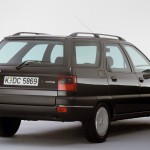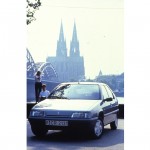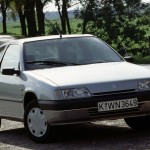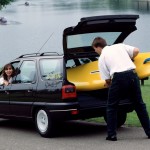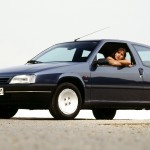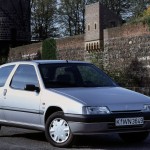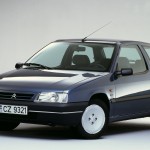
(English below)
Vor 25 Jahren, im Jahr 1991, feierte der Citroën ZX auf dem Genfer Automobilsalon seine Weltpremiere. Die Schräghecklimousine ordnete sich zwischen dem Citroën AX und dem Citroën BX ein und war das erste speziell für die Kompaktklasse entwickelte Modell von Citroën.
Der Citroën ZX – fünf Sitze, Fünftürer und Frontantrieb – war das erste europäische Fahrzeug mit einer längsverschiebbaren Rückbank und einer neigungsverstellbaren Rückenlehne. Zudem bot es den längsten Innenraum in seinem Segment. Eine technologische Innovation beim Citroën ZX: die programmiert mitlenkende Hinterachsaufhängung, die ein leichtes Einlenken der Hinterräder in Kurvenrichtung erlaubte und so die Straßenlage erheblich verbesserte.
Im März 1991 kam der Citroën ZX mit vier Ausstattungslinien – Reflex, Avantage, Aura und Volcane – auf den Markt, die jeweils für vier verschiedene Käufertypen bestimmt waren. Zur Auswahl standen Vierzylinder-Benzinmotoren mit 55 kW/75 PS (1.360 cm³), 65 kW/88 PS (1.580 cm³) und 88 kW/120 PS (1.580 cm³). Mit dieser Modellreihe vervollständigte Citroën das Angebot für den Mittelklassemarkt und unterstrich seinen Anspruch, ein “Generalist” zu sein.
Noch im selben Jahr wurde der Citroën ZX 1,9 l Diesel mit EGR und Katalysator auf der IAA in Frankfurt präsentiert. Das auf der Basis des XUD-Motors entwickelte ZX-Dieseltriebwerk entsprach den Wünschen der Kunden und erfüllte selbst die strengsten Umweltschutznormen. Im November 1991 zeichnete die französische Zeitschrift “Auto Moto” den Citroën ZX Diesel Avantage als “Diesel-König” aus.
Im Februar 1992 gingen zwei internationale Preise an den Citroën ZX: die Goldmedaille der “Association française de la presse automobile” (französischer Verband der Automobilpresse) und der Preis “Auto Europa”, der vom italienischen Autojournalistenverband verliehen wird.
Einen Monat später wurde der Citroën ZX durch vier neue Varianten mit ZF 4-Gang-Automatik erweitert: zwei Benziner (Citroën ZX Volcane mit 120 PS/88 kW und Citroën ZX Aura mit 88 PS/65 kW) sowie zwei Diesel (Citroën ZX Aura und Citroën ZX Avantage mit 64 PS/47 kW). Der Citroën ZX wurde somit in vierzehn Modellvarianten angeboten.
Mit der Markteinführung des Citroën ZX Turbodiesel im Sommer 1992 zog ein „Spaß-Diesel“ in die Kompaktklasse ein. Der neue Turbodieselmotor mit Ladeluftkühler holte aus 1.905 cm³ 90 PS (66 kW) bei 4.000 U/min und bot eine für damalige Verhältnisse herausragende Spitzengeschwindigkeit von 185 km/h.
Im Herbst 1992 debütierten zwei neue dreitürige Versionen des Citroën ZX: der ZX Aura Turbodiesel und der ZX Aura 1.8i. Diese Coupés setzten durch ihre hervorragende Ausstattung neue Impulse für das Image der ZX Modelle.
In den Folgejahren wuchs die Modellpalette des Citroën ZX weiter – unter anderem um den Kombi, der in zwei Ausstattungslinien auf den Markt kam und viel Raum sowie gutes Fahrverhalten bot. Die Sonderserien ZX Tonic und ZX Kombi Tonic richteten sich an eine junge, designbewusste Kundschaft und waren als Drei- und Fünftürer erhältlich.
Citroën ZX Rallye Raid
Im Zuge der Markteinführung des Citroën ZX im Jahr 1991 präsentierte die Marke den 300 PS starken, Allrad angetriebenen ZX Rallye Raid und verkündete damit offiziell ihren Einstieg in den internationalen Motorsport. Bis 1997 engagierte sich Citroën Sport mit großem Erfolg bei der Rallye Raid und konnte bereits beim Auftakt des Motorsport-Engagements erste Triumphe feiern: Die beiden Fahrerteams Ari Vatanen/Bruno Berglund sowie Jacky Ickx/Christian Tarin belegten 1990 mit einem Prototyp des Fahrzeugs bei der Rallye Aragon in Spanien die ersten beiden Plätze. Bis zum Ausstieg aus der Rennserie im Jahr 1997 gewann Citroën bei der Rallye Raid fünf Konstrukteursmeisterschaften in Folge (1993 bis 1997). Im selben Zeitraum entschied Citroën mit seinen Piloten Pierre Lartigue/Michel Périn die renommierte Rallye Paris-Dakar drei Mal hintereinander für sich.
Nachtrag der Amicale – Bestands-Zahlen und Clubunterstützung
Beim Kraftfahrtbundesamt (KBA) Flensburg waren zum 1.1.2014 unter den TSN (Typschlüsselnummern) 210, 214, 218, 219, 220, 221, 239, 240, 241, 242, 260, 261, 262, 298, 611, 612, 613, 614, 615, 616, 618, 619, 620, 621 und 622 noch insgesamt 1.798 Fahrzeuge der Handelsbezeichung “ZX” (amtlicher Typ-Text “N2”) verzeichnet. Es kann nicht ausgeschlossen werden, daß weitere ZX entweder nicht den passenden TSN zugewiesen wurden, z.B. durch Importe etc. sodaß die Anzahl der ZX in Deutschland noch höher sein kann.
Der Citroën ZX, damals auch unter dem Slogan “Golf-Klasse” vermarktet, wird vorrangig in Deutschland durch den André Citroën-Club (www.andre-citroen-club.de) repräsentiert, in dem sich Enthusiasten für Fahrzeuge aller Baujahre von 1919 bis heute austauschen. Auf den Clubforen-Seiten (www.andre-citroen-club.de/forums) ist insbesondere die Suche nach Fahrzeugen und Ersatzteilen möglich.
—–
A Special Anniversary – 25 Years of Citroën ZX
(Translation by Amicale)
In 1991, Citroën’s newest model, the “ZX”, had its world premiere at the Geneva Motor Show. The hatchback was positioned between the models “Citroën AX” and “Citroën BX” and was the first model specifically designed for the compact class segment of Citroën.
The Citroën ZX – with five seats, five-door and front wheel drive – was the first European car with a longitudinal sliding rear bench seat and a tilt-adjustable backrest. It also offered the longest interior in its segment. A technological innovation was also deployed with the Citroën ZX: the “programmed” co-steering rear axle which allowed an easy give in the rear wheels in the turning direction, thus greatly improving the roadholding.
In March 1991, the Citroën ZX came with four trim levels – “Reflex”, “Avantage”, “Aura” and “Volcane” – determined for four different types of buyers on the market. The choice was between four-cylinder gasoline engines with 55kW / 75hp (1,360 cc), 65kW / 88hp (1,580cc) and 88kW / 120hp (1,580cc). With this model Citroën completed the portfolio for the middle class market and underlined the claim to be a “generalist”.
That same year, the Citroën ZX 1.9 liter diesel with EGR (exhaust gas recirculation) and catalytic converter was presented at the IAA motor show in Frankfurt. Developed on the basis of the XUD engine, the new ZX diesel engine addressed the wishes of the customers and fulfilled the most stringent environmental standards. In November 1991, the French magazine “Auto Moto” awarded the Citroën ZX Diesel Avantage as “diesel king”.
In February 1992, two international awards went to the Citroën ZX: the gold medal of the “Association française de la presse automobile” (French Association of the Automotive Press), and the prize “Auto Europa”, awarded by the Italian car Journalists Association.
A month later, the Citroën ZX has been extended by four new variants with ZF 4-speed automatic transmission: two petrol (“Citroën ZX Volcane” with 120hp / 88kW and “Citroën ZX Aura” with 88hp / 65kW) and two diesel (“Citroën ZX Aura” and “Citroën ZX Avantage” with 64hp / 47kW). The Citroën ZX was thus offered in fourteen different model variants.
With the launch of the Citroën ZX turbodiesel in the summer of 1992, a “fun-diesel” (German marketing slogan: “Spass-Diesel”) was introduced in the compact class. The new turbo diesel engine with intercooler had a 1,905cc 90hp / 66 kW engine at 4000 rev/min and offered – outstanding for its time – a top speed of 185km/h.
In autumn 1992, two new three-door versions of the Citroën ZX debuted: the “ZX Aura Turbodiesel and the ZX Aura 1.8i. These coupes set by its superb features new impulses to the image of the ZX models.
In subsequent years, the model range of Citroën ZX continued to grow – especially addressing the “break” estate version which came in two trim lines to the market, offering plenty of space and good driveability. The special series “Tonic ZX” and “ZX Tonic Kombi” (break) were aimed at a young, design-conscious customer audience and were available in three- and five-door variants.
Citroën ZX Rallye Raid
As part of the launch of the Citroën ZX in 1991, the brand presented the 300-horsepower, four-wheel driven “ZX Rallye Raid” and announced officially its entry into the international motorsport. Until 1997 Citroën Sport participated with great success in the Rally Raid and was already at the launch of the motorsport commitment able to celebrate first triumphs: The two driver teams Ari Vatanen / Bruno Berglund and Jacky Ickx / Christian Tarin set a great success in 1990 with a prototype of the vehicle at the Rally Aragon in Spain and won the first two places. Until the withdrawal from the race series in 1997, Citroën won five constructors’ championships in a row (1993 until 1997) in the Rally Raid. During the same period Citroën won with the pilots Pierre Lartigue / Michel Périn the prestigious Paris-Dakar Rally three times in a row.
Annotation by Amicale Citroën and DS Germany – inventory numbers and club support
In Germany, the national Federal Motor Transport Authority (“Kraftfahrtbundesamt”, KBA) Flensburg had registered in 2014 under the TSN (type code numbers) 210, 214, 218, 219, 220, 221, 239, 240, 241, 242, 260, 261, 262, 298, 611, 612, 613 , 614, 615, 616, 618, 619, 620, 621 and 622 a total of 1,798 vehicles sold as “ZX” (official type text “N2”). It can be assumed that further ZX were either not allocated to the matching TSN, for example when imported from foreign countries etc. so that the number of ZX can be even higher in Germany.
The Citroën ZX, marketed under the slogan “Golf class”, is in Germany primarily represented by the André Citroën Club (ACC) (www.andre-citroen-club.de) in which Citroën enthusiasts of vehicles of all model years from 1919 until today are represented. The club’s (German spoken) internet forum (www.andre-citroen-club.de/forums) allows particularly to search for vehicles and spare parts of the ZX and other models.
